Multifunctional Detection Sensor and Sensitivity Improvement of a Double Solenoid Coil Sensor
Abstract
1. Introduction
2. Chip Design and Detection Model
2.1. Chip Design
2.2. Inductance Detection Mode
2.3. Capacitance Detection Mode
3. Chip Fabrication and Experimental Preparation
3.1. Chip Fabrication
3.2. Construction of the Detection System
3.3. Sample Preparation
4. Results and Discussion
4.1. Inductance Detection Results and Discussion
4.2. Capacitance Detection Results and Discussion
5. Conclusions
Author Contributions
Funding
Acknowledgments
Conflicts of Interest
References
- Zhang, H.; Zeng, L.; Teng, H.; Zhang, X. A Novel On-Chip Impedance Sensor for the Detection of Particle Contamination in Hydraulic Oil. Micromachines 2017, 8, 249. [Google Scholar] [CrossRef] [PubMed]
- Zhu, X.; Zhong, C.; Zhe, J. Lubricating oil conditioning sensors for online machine health monitoring—A review. Tribol. Int. 2017, 109, 473–484. [Google Scholar] [CrossRef]
- Zeng, L.; Yu, Z.; Zhang, H.; Zhang, X.; Chen, H. A high sensitive multi-parameter micro sensor for the detection of multi-contamination in hydraulic oil. Sens. Actuators A Phys. 2018, 282, 197–205. [Google Scholar] [CrossRef]
- Du, L.; Zhe, J. Parallel sensing of metallic wear debris in lubricants using undersampling data processing. Tribol. Int. 2012, 53, 28–34. [Google Scholar] [CrossRef]
- Shi, H.; Zhang, H.; Gu, C.; Wang, W. Multi-parameter sensor for hydraulic oil pollutant. Chin. J. Sci. Instrum. 2018, 39, 172–179. [Google Scholar]
- Zhang, H.; Bai, C.; Sun, G.; Zeng, L. High-throughput miniature multi-parameter oil contamination detection sensor. Opt. Precis. Eng. 2018, 26, 2237–2244. [Google Scholar]
- Sun, G.; Zhang, H.; Gu, C.; Bai, C.; Zeng, L. High precision microfluidic multi-parameter hydraulic oil detection chip design. Chin. J. Sci. Instrum. 2019, 59–66. [Google Scholar]
- Li, D.; Jiang, Z. On-Line Wear Debris Detection in Lubricating Oil for Condition Based Health Monitoring of Rotary Machinery. Recent Pat. Electr. Eng. 2011, 4, 1–9. [Google Scholar]
- Du, L.; Zhe, J.; Carletta, J.; Veillette, R.; Choy, F. Real-time monitoring of wear debris in lubrication oil using a microfluidic inductive Coulter counting device. Microfluid. Nanofluid. 2010, 9, 1241–1245. [Google Scholar] [CrossRef]
- Wu, Y.; Zhang, H. Research on the effect of relative movement on the output characteristic of inductive sensors. Sens. Actuators A Phys. 2017, 267, 485–490. [Google Scholar] [CrossRef]
- Bo, Z.; Zhang, X.M.; Zhang, H.P.; Liu, E.C.; Chen, H.Q. Iron Wear Particle Content Measurements in Process Liquids Using Micro Channel—Inductive Method. Key Eng. Mater. 2015, 645–646, 756–760. [Google Scholar] [CrossRef]
- Chao, X.U.; Zhang, P.L.; Ren, G.Q.; Wang, Z.J. Output Characteristic of a Novel Online Ultrasonic Wear Debris Sensor. Tribology 2015, 35, 90–95. [Google Scholar]
- Wu, Y.; Zhang, H.; Wang, M.; Chen, H. Differentiation of nonferrous metal particles in lubrication oil using an electrical conductivity measurement-based inductive sensor. Rev. Sci. Instrum. 2018, 89, 025002. [Google Scholar] [CrossRef] [PubMed]
- Jagtiani, A.V.; Carletta, J.; Zhe, J. A microfluidic multichannel resistive pulse sensor using frequency division multiplexing for high throughput counting of micro particles. J. Micromech. Microeng. 2011, 21, 065004. [Google Scholar] [CrossRef]
- Zubair, M.; Tang, T. A High Resolution Capacitive Sensing System for the Measurement of Water Content in Crude Oil. Sensors 2014, 14, 11351–11361. [Google Scholar] [PubMed]
- Murali, S.; Jagtiani, A.V.; Xia, X.; Carletta, J.; Zhe, J. A microfluidic Coulter counting device for metal wear detection in lubrication oil. Rev. Sci. Instrum. 2009, 80, 016105. [Google Scholar] [CrossRef] [PubMed]
- Muthuvel, P.; George, B.; Ramadass, G.A. Magnetic-Capacitive Wear Debris Sensor Plug for Condition Monitoring of Hydraulic Systems. IEEE Sens. J. 2018, 18, 9120–9127. [Google Scholar] [CrossRef]
- Han, Z.; Wang, Y.; Qing, X. Characteristics Study of In-Situ Capacitive Sensor for Monitoring Lubrication Oil Debris. Sensors 2017, 17, 2851–2864. [Google Scholar] [CrossRef]
- Demori, M.; Ferrari, V.; Strazza, D.; Poesio, P. A capacitive sensor system for the analysis of two-phase flows of oil and conductive water. Sens. Actuators A Phys. 2010, 163, 172–179. [Google Scholar] [CrossRef]
- Flanagan, J.M.; Jordan, J.R.; Whittington, H.W. Wear-debris detection and analysis techniques for lubricant-based condition monitoring. J. Phys. E Sci. Instrum. 1988, 21, 1011. [Google Scholar] [CrossRef]
- Yan, H.; Zhang, Y. The Design of an On-line Monitoring Sensor of Wear Mental Particals and the Analysis of Its Characteristic. J. Transcluction Technol. 2002, 333–338. [Google Scholar] [CrossRef]
- Fan, H.B.; Zhang, Y.T.; Li, Z.N.; Ren, G.Q. Study on Magnetic Characteristic of Ferromagnetic Wear Debris in Inductive Wear Debris Sensor. Tribology 2009, 29, 452–457. [Google Scholar]
- Du, L.; Zhe, J. A high throughput inductive pulse sensor for online oil debris monitoring. Tribol. Int. 2011, 44, 175–179. [Google Scholar] [CrossRef]
- Du, L.; Zhu, X.; Han, Y.; Zhao, L.; Zhe, J. Improving sensitivity of an inductive pulse sensor for detection of metallic wear debris in lubricants using parallel LC resonance method. Meas. Sci. Technol. 2013, 24, 75106. [Google Scholar] [CrossRef]
- Zhu, X.; Zhong, C.; Zhe, J. A high sensitivity wear debris sensor using ferrite cores for online oil condition monitoring. Meas. Sci. Technol. 2017, 28, 075102. [Google Scholar] [CrossRef]
- Zeng, L.; Zhang, H.; Zhao, X.; Teng, H.; Yu, Z. Double coil multi-parameter impedance sensor for hydraulic oil pollutants detection. Chin. J. Sci. Instrum. 2017, 38, 1690–1697. [Google Scholar]
- Lin, Z.; Zhang, H.; Teng, H.; Zhang, X. Novel Method for the Detection of Multi-contaminants in Marine Lubricants. J. Mech. Eng. 2018, 54, 125. [Google Scholar]
- Shi, H.; Zhang, H.; Gu, C.; Zeng, L. A multi-parameter on-chip impedance sensor for the detection of particle contamination in hydraulic oil. Sens. Actuators A Phys. 2019, 293, 150–159. [Google Scholar] [CrossRef]
- Lei, Y. Analytical Method of Time Harmonic Electromagnetic Field; Science Press: Beijing, China, 2000. [Google Scholar]
- Zhang, X.; Zhang, H.; Chen, H.; Zhang, Y. Study on the resolution-frequency characteristic of microfluidic oil detection chip. Chin. J. Sci. Instrum. 2014, 35, 427–433. [Google Scholar]
- Hu, X.; Yang, W. Planar capacitive sensors—Designs and applications. Sens. Rev. 2010, 30, 24–39. [Google Scholar] [CrossRef]
- Zhang, H.; Huang, W.; Zhang, Y.; Shen, Y.; Li, D. Design of the microfluidic chip of oil detection. Appl. Mech. Mater. 2012, 117, 517–520. [Google Scholar] [CrossRef]
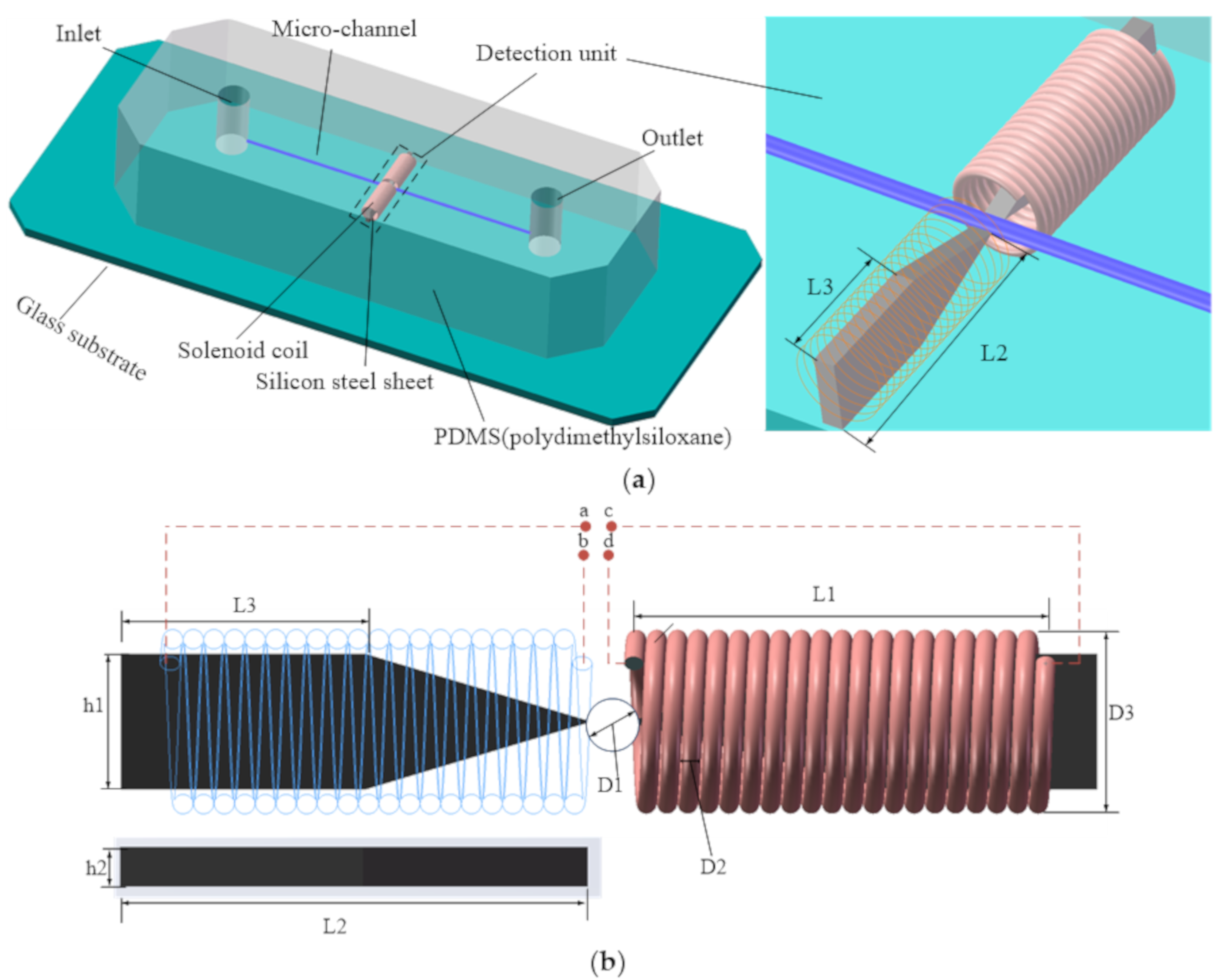
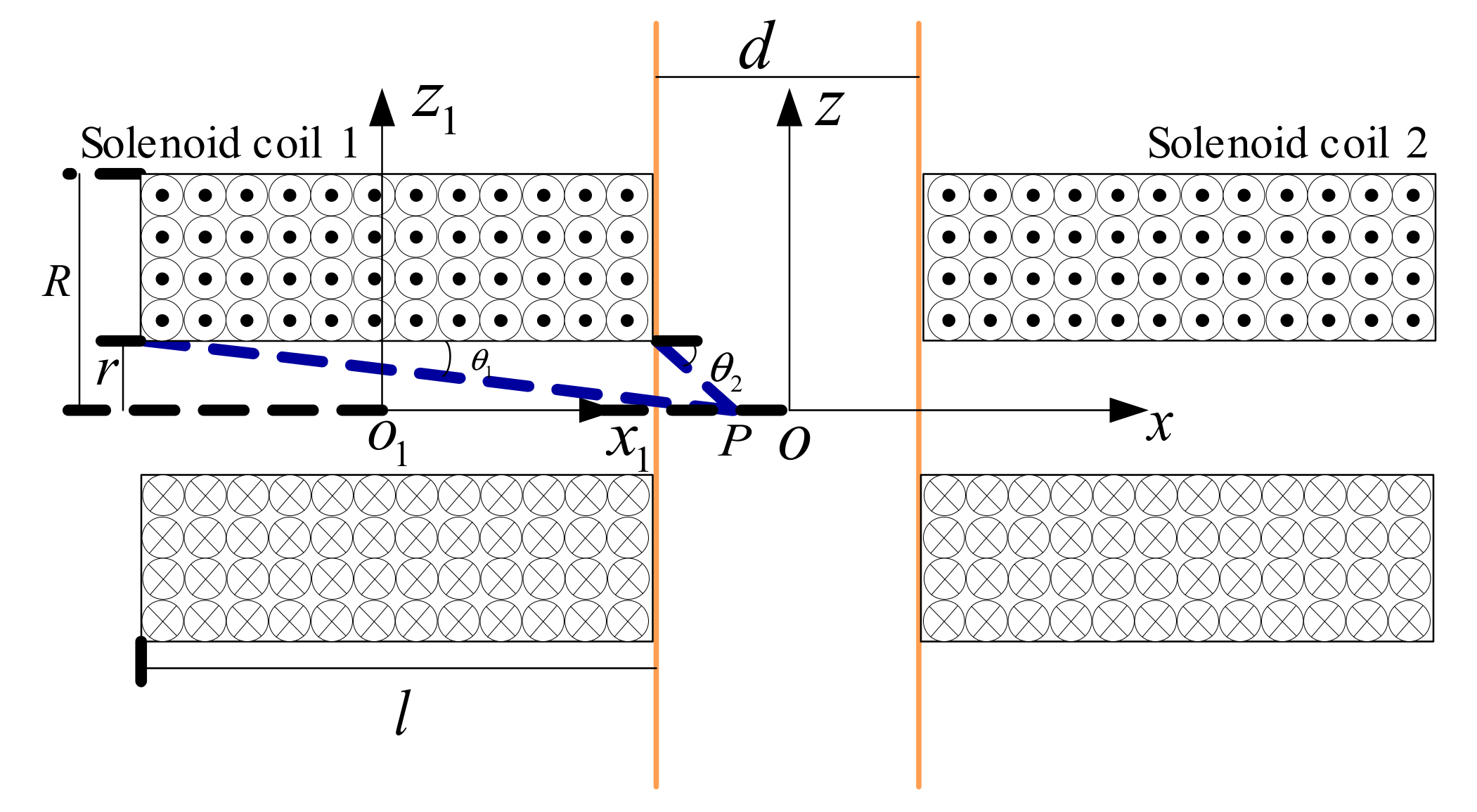
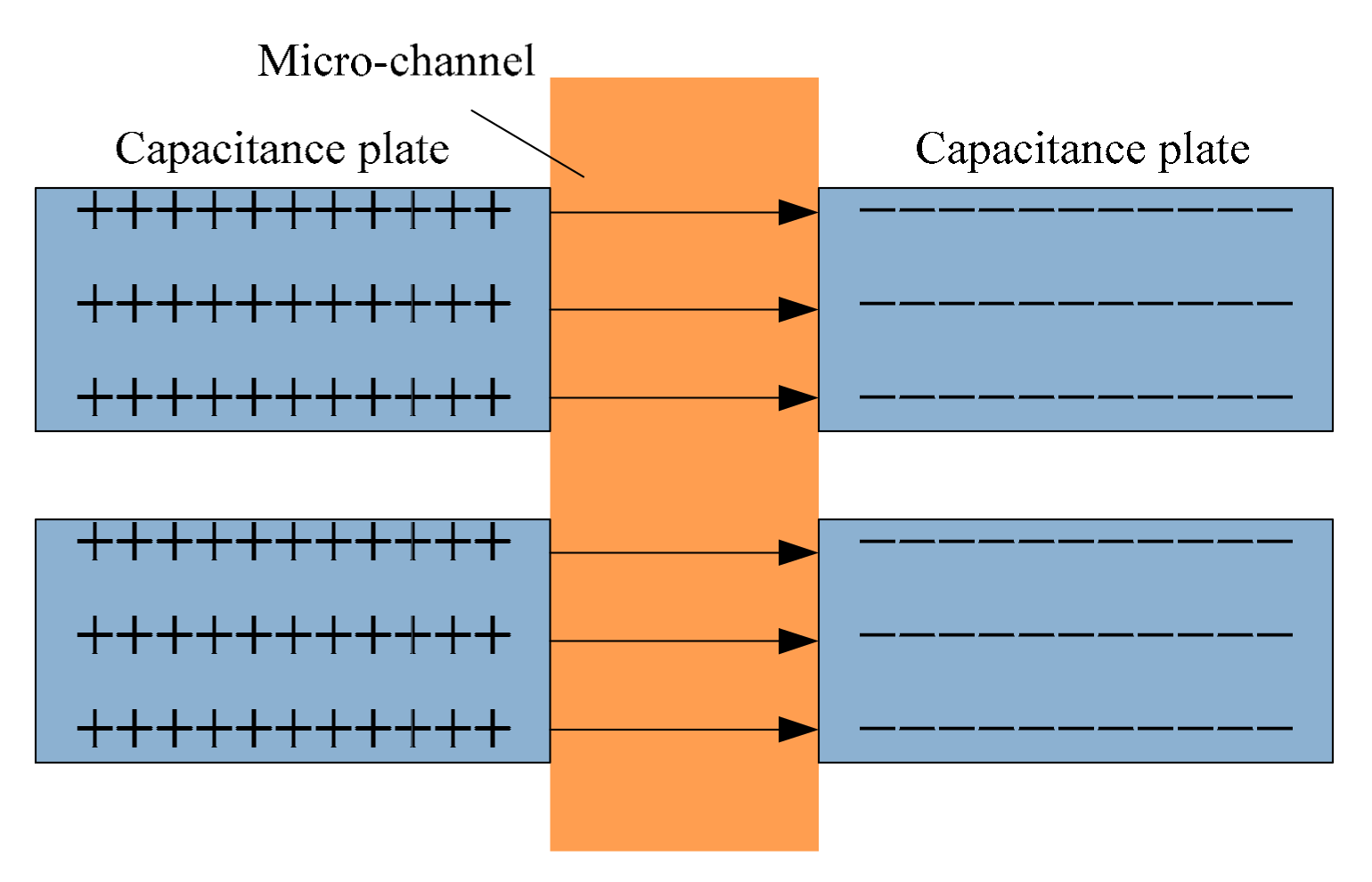
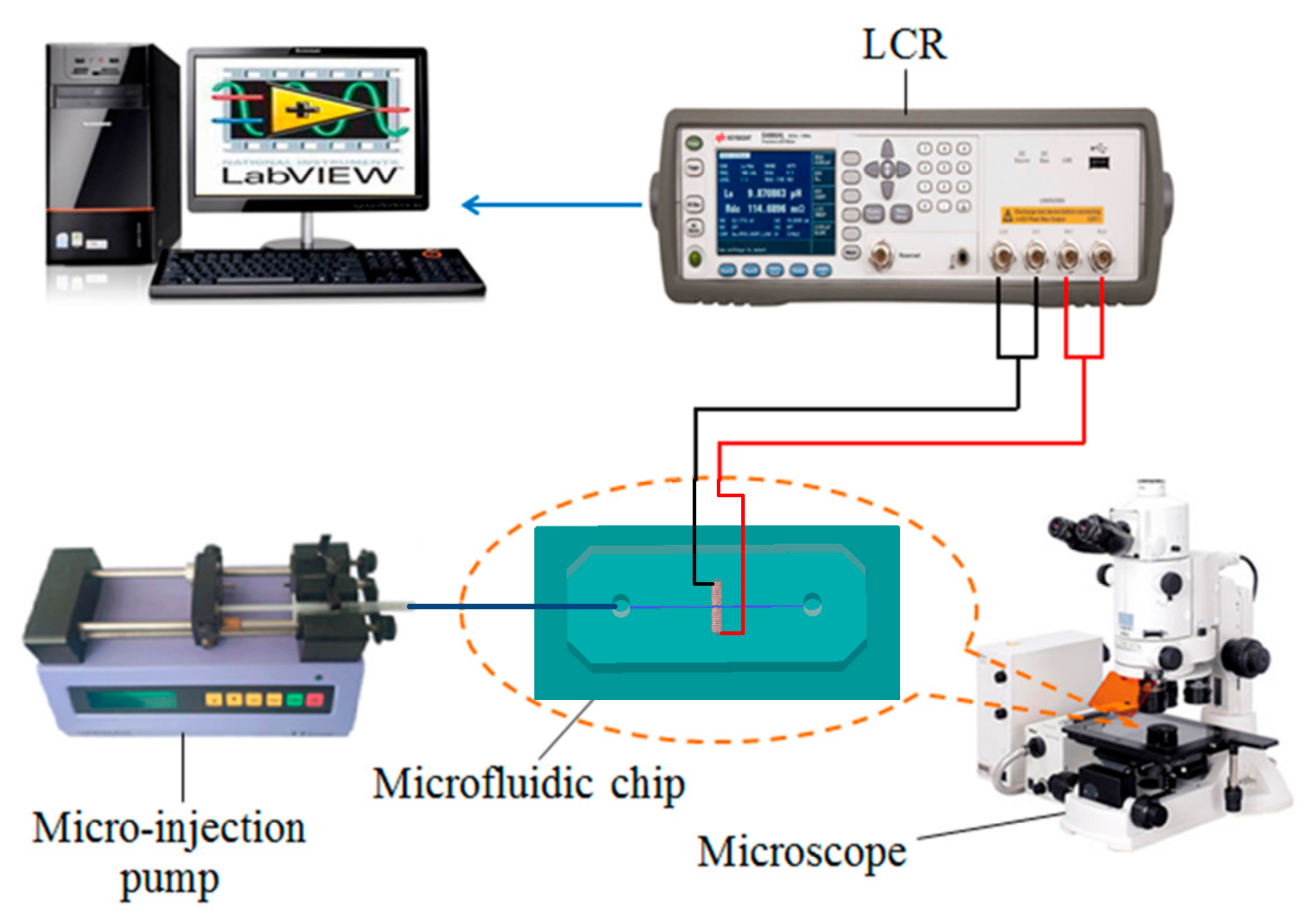
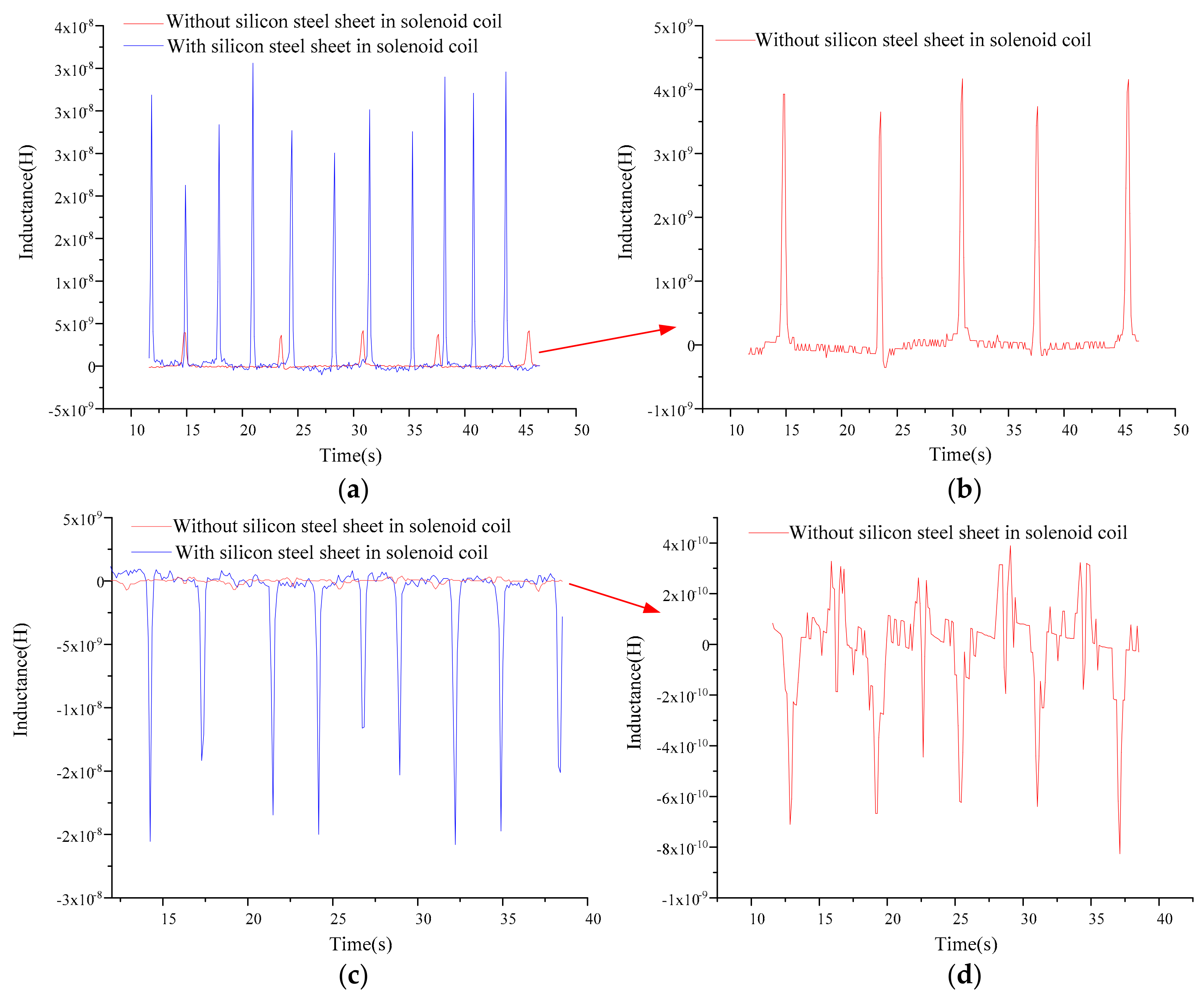
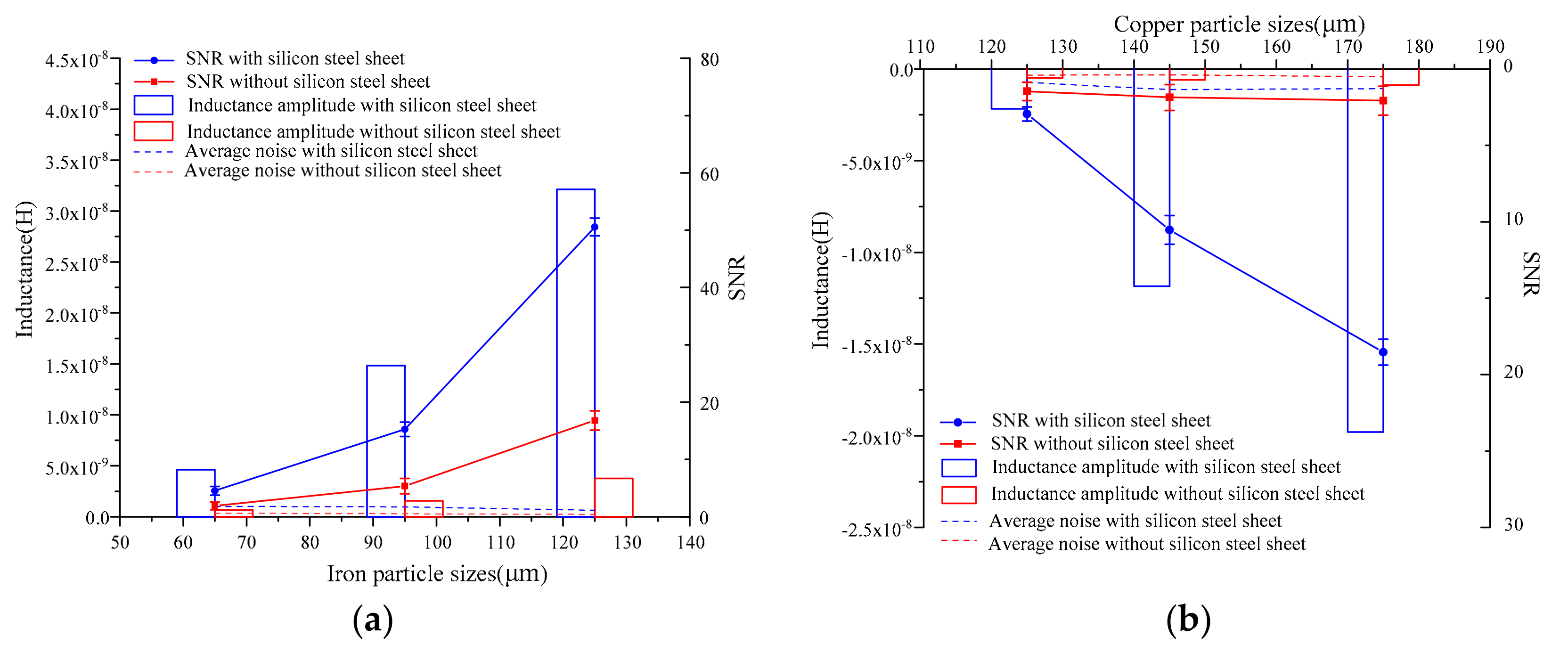
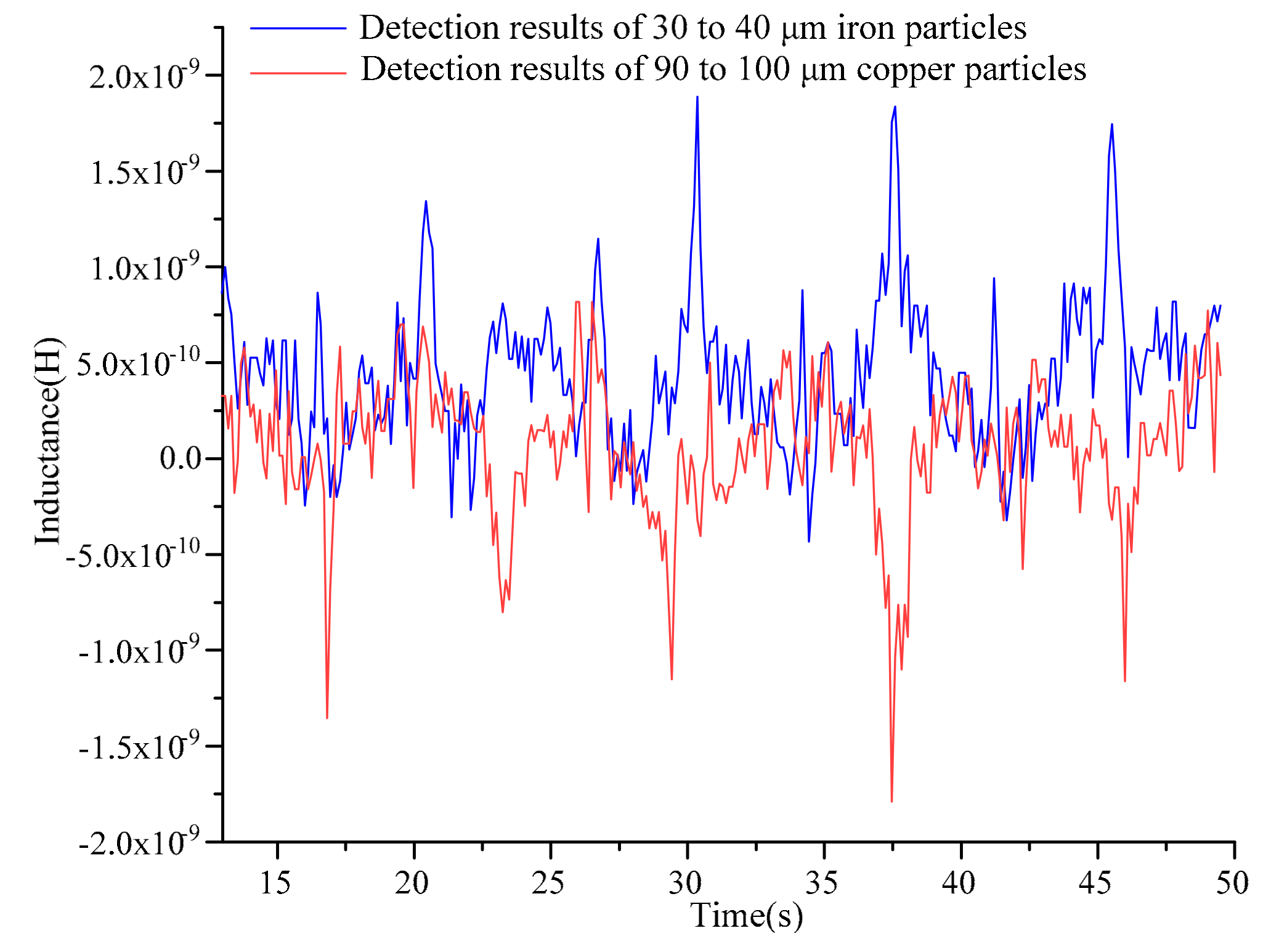
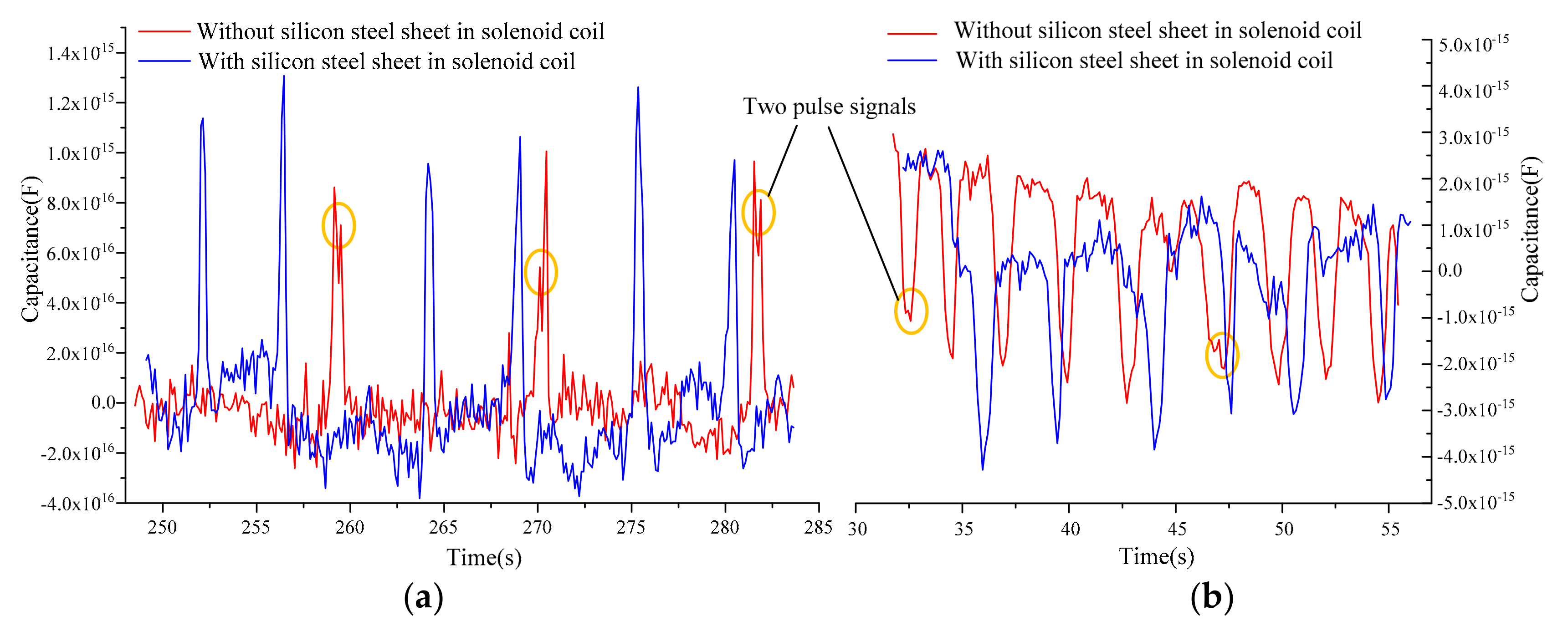
| Particles | Chip Structure | Average Amplitude (F) | Average Noise (F) | SNR |
|---|---|---|---|---|
| water droplets (140–150 μm) | with silicon steel sheets | 1.26 × 10−15 | 4.71 × 10−16 | 2.67 |
| without silicon steel sheets | 9.17 × 10−16 | 4.19 × 10−16 | 2.19 | |
| Bubbles (240–250 μm) | with silicon steel sheets | 4.73 × 10−15 | 1.83 × 10−16 | 2.58 |
| without silicon steel sheets | 3.99 × 10−15 | 1.67 × 10−16 | 2.39 |
© 2019 by the authors. Licensee MDPI, Basel, Switzerland. This article is an open access article distributed under the terms and conditions of the Creative Commons Attribution (CC BY) license (http://creativecommons.org/licenses/by/4.0/).
Share and Cite
Ma, L.; Xu, Z.; Zhang, H.; Qiao, W.; Chen, H. Multifunctional Detection Sensor and Sensitivity Improvement of a Double Solenoid Coil Sensor. Micromachines 2019, 10, 377. https://doi.org/10.3390/mi10060377
Ma L, Xu Z, Zhang H, Qiao W, Chen H. Multifunctional Detection Sensor and Sensitivity Improvement of a Double Solenoid Coil Sensor. Micromachines. 2019; 10(6):377. https://doi.org/10.3390/mi10060377
Chicago/Turabian StyleMa, Laihao, Zhiwei Xu, Hongpeng Zhang, Weiliang Qiao, and Haiquan Chen. 2019. "Multifunctional Detection Sensor and Sensitivity Improvement of a Double Solenoid Coil Sensor" Micromachines 10, no. 6: 377. https://doi.org/10.3390/mi10060377
APA StyleMa, L., Xu, Z., Zhang, H., Qiao, W., & Chen, H. (2019). Multifunctional Detection Sensor and Sensitivity Improvement of a Double Solenoid Coil Sensor. Micromachines, 10(6), 377. https://doi.org/10.3390/mi10060377





